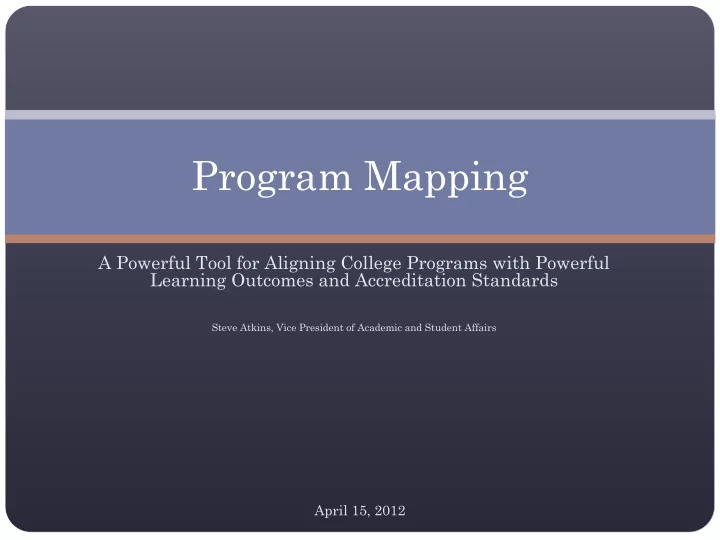

Program Mapping A Powerful Tool for Aligning College Programs with Powerful Learning Outcomes and Accreditation Standards Steve Atkins, Vice President of Academic and Student Affairs April 15, 2012
Session Outcomes Gain a general understanding of mapping Describe briefly at least three uses for mapping Use mapping to demonstrate quality by adhering to external standards of excellence Develop outcomes – Mapping programs – start with the “end in mind”
Questions Do you understand student course-taking patterns? Do you understand the progression of required and elective courses and skill and concept development? Do faculty ever discuss the level at which individual courses really are taught? When you propose a course, can you successfully advocate to a curriculum committee what the course contributes to the whole? What do your students say about gaps in learning opportunities? Ruth Stiehl (2002). The Outcomes Primer: Reconstructing the College Curriculum: The Learning Organization
What is Mapping? Produces a picture of a curriculum or program created when you apply a variety of “lenses” as analysis tools Can be simple or intricate Provides a basis for targeted collaboration regarding a curriculum or program
Program Level Map Ruth Stiehl (2002). The Outcomes Primer: Reconstructing the College Curriculum: The Learning Organization
AS – Accounting Technology
Drafting
Cardiovascular Technology
Management and Supervision: Curriculum Map (Program Level Outcomes) Course or Experience Analysis Graduates Graduates Graduates Approach understanding application of application of economics HR engagement of marketing and business… principles… principles… Intro to Business Management (us 100) SLO Addressed Yes Yes Yes Security Awareness for Managers (Bus SLO Addressed 106) Business protocol (Bus 110) SLO Addressed Yes Principles of Supervision I (BUS111) SLO Addressed Yes Principles of Supervision II (BUS112) SLO Addressed Yes Entrepreneurship (BUS 116) SLO Addressed Yes Leadership Development (BUS 117) SLO Addressed Yes Concepts Supervision (BUS 118) SLO Addressed Yes Business Mathematics I(BUS 121) SLO Addressed Yes Yes Business Mathematics II (BUS 122) SLO Addressed Yes Yes Small Business Management (BUS 165) SLO Addressed Yes Yes Yes WEAVEonline: Assessing Achievement on Institutional Mission http://www.weaveonline.com/PHPages/wp-content/uploads/2010/04/Newsletter_Spring_2010.pdf#page=2
Management and Supervision: Curriculum Map (Levels of Instruction) Course or Experience Analysis Approach Graduates Graduates Graduates understanding application of application of economics HR engagement of marketing and business… principles… principles… Intro to Business Management (us 100) Level of Instruction 1 Introduced 1 Introduced 1 Introduced Security Awareness for Managers (Bus Level of Instruction 106) Business protocol (Bus 110) Level of Instruction 2 Reinforced Principles of Supervision I (BUS111) Level of Instruction 2 Reinforced Principles of Supervision II (BUS112) Level of Instruction 3 Emphasized Entrepreneurship (BUS 116) Level of Instruction 1 Introduced Leadership Development (BUS 117) Level of Instruction 2 Reinforced Concepts Supervision (BUS 118) Level of Instruction 2 Reinforced Business Mathematics I(BUS 121) Level of Instruction 2 Reinforced 2 Reinforced Business Mathematics II (BUS 122) Level of Instruction 2 Reinforced 2 Reinforced Small Business Management (BUS 165) Level of Instruction 3 Emphasized 3 Emphasized 3 Emphasized WEAVEonline: Assessing Achievement on Institutional Mission http://www.weaveonline.com/PHPages/wp-content/uploads/2010/04/Newsletter_Spring_2010.pdf#page=2
Management and Supervision: Curriculum Map (General Education Outcomes) Course or Experience Analysis Communi- Quantitative Critical SQR Approach cations literacy Thinking Intro to Business Management (us 100) SLO Yes Yes Yes Addressed Security Awareness for Managers (Bus 106) SLO Yes Yes Yes Addressed Business protocol (Bus 110) SLO Yes Yes Yes Addressed Principles of Supervision I (BUS111) SLO Yes Yes Yes Addressed Principles of Supervision II (BUS112) SLO Yes Yes Yes Addressed Entrepreneurship (BUS 116) SLO Yes Yes Yes Addressed Leadership Development (BUS 117) SLO Yes Yes Yes Addressed Concepts Supervision (BUS 118) SLO Yes Yes Addressed Business Mathematics I(BUS 121) SLO Yes Yes Yes Addressed Business Mathematics II (BUS 122) SLO Yes Yes Yes Addressed Small Business Management (BUS 165) SLO Yes Yes Yes Addressed WEAVEonline: Assessing Achievement on Institutional Mission http://www.weaveonline.com/PHPages/wp-content/uploads/2010/04/Newsletter_Spring_2010.pdf#page=2
Utilization Maps For Professional/Accreditation Standards Course or Experience Analysis Apply math, Design and Design a Function on Identify, Approach science, and conduct system, multi- formulate, engineering experiments component disciplinary and solve principles or processes teams engineering for needs problems Introduction to Aerospace ABET Yes/Addressed (AERO 201) Program Outcomes Aerospace mechanics (Aero ABET Outcome A Outcome B Outcome E 211) Program Outcomes Thermodynamics for ABET Outcome A Outcome B Outcome E Aerospace (AERO 212) Program Outcomes Material Science for Engineers ABET Outcome A Outcome C Outcome D Outcome E (AERO 213) Program Outcomes Engineering Principles of ABET Outcome A Outcome D Continuum Mechanics (AERO Program 214) Outcomes Introduction to Aerospace ABET Outcome A Outcome C Computation (AERO220) Program Outcomes Special Topics in… (AERO 289) ABET Outcome A Outcome C Outcome E Program Outcomes Research (Aero 291) ABET Outcome A Outcome B Outcome D Outcome E Program Outcomes WEAVEonline: Assessing Achievement on Institutional Mission http://www.weaveonline.com/PHPages/wp-content/uploads/2010/04/Newsletter_Spring_2010.pdf#page=2
Resources Richard Paul and Linda Elder’s The Miniature Guide for Those Who Teach on How to Improve Student Learning (2002). Pp. 43-44. Gerald Nosich’s Learning to Think Things Through: A Guide to Critical Thinking Across the Curriculum (2005). Pearson, Prentice Hall. Seattle Central Community College: Curriculum Coordinating Council http://seattlecentral.edu/users/crc/Assessment/IA_Writing_Course_Outcomes .htm University of Connecticut: Assessment http://assessment.uconn.edu/docs/HowToWriteObjectives Outcomes .pdf League for Innovation: Istream http://www.league.org/istreamSite/lens_index.cfm?gr=yes&visible=block Ruth Stiehl’s The Outcomes Primer: Reconstructing the College Curriculum (2002). The Learning Organization. WEAVEonline: Assessing Achievement on Institutional Mission http://www.weaveonline.com/PHPages/wp- content/uploads/2010/04/Newsletter_Spring_2010.pdf#page=2
Recommend
More recommend